Effect of Electropulsing Treatment on the Fatigue Crack Growth Behavior of Copper
Abstract
1. Introduction
2. Experimental Details
2.1. Specimen
2.2. Fatigue Test and Application of EPT
2.3. Observation of Crack Growth and Fracture Surfaces
3. Results
3.1. Fatigue Failure Lives
3.2. Microhardness Test
3.3. Fatigue Crack Growth Behavior
3.4. Observation of the Fatigue Crack Tip
3.5. Fracture Surface
4. Discussion
5. Conclusions
- The S–N curves of the specimens with and without EPT followed the Manson–Coffin relationship and exhibited a single slope behavior for the variation of cyclic stress amplitude from low- to high-cycle regions.
- The EPT with current density of 150 A/mm2 enhanced high-cycle fatigue life. This enhanced effect tends to increase with the decrease in cyclic stress. However, the electric current hardly affects the low-cycle fatigue life of copper specimens.
- The measurement of microhardness revealed evidence on releasing of cyclic hardening through EPT, that is, the local recrystallization occurred around the tip of the fatigue crack. Crack propagation was delayed during the first few thousand cycles after the treatment, then regained the initial growth curve to failure.
- In the present test, no evidence of melting or blunting was observed around the crack tip on the fracture surfaces by SEM. Thus, the increase of fatigue life by EPT was mainly caused by local annealing and recrystallization around the fatigue crack tip.
- From a microscopic viewpoint, a minimal difference exists between the propagation and the final fracture regions on the fracture surfaces of specimens with and without EPT. Therefore, the fracture mechanism remains unchanged after the EPT.
Author Contributions
Funding
Conflicts of Interest
References
- Ma, B.; Zhao, Y.; Bai, H.; Ma, J.; Zhang, J.; Xu, X. Gradient Distribution of Mechanical Properties in the High Carbon Steel Induced by the Detour Effect of the Pulse Current. Mater. Des. 2013, 49, 168–172. [Google Scholar] [CrossRef]
- Roh, J.; Seo, J.; Hong, S.; Kim, M.; Han, H.N.; Roth, J.T. The Mechanical Behavior of 5052-H32 Aluminum Alloys under a Pulsed Electric Current. Int. J. Plast. 2014, 58, 84–99. [Google Scholar] [CrossRef]
- Zhou, Y.; Xiao, S.; Guo, J. Recrystallized Microstructure in Cold Worked Brass Produced by Electropulsing Treatment. Mater. Lett. 2004, 58, 1948–1951. [Google Scholar] [CrossRef]
- Conrad, H.; White, J.; Cao, W.D.; Lu, X.P.; Sprecher, A.F. Effect of Electric Current Pulses on Fatigue Characteristics of Polycrystalline Copper. Mater. Sci. Eng. A Struct. 1991, 145, 1–12. [Google Scholar] [CrossRef]
- Cao, W.D.; Conrad, H. On the Effect of Persistent Slip Band (PSB) Parameters on Fatigue Life. Fatigue Fract. Eng. Mater. Struct. 1992, 15, 573–583. [Google Scholar] [CrossRef]
- Wang, C.; Bao, T. Effect of Pulse Current on Thermal Fatigue Behavior of Hot Work Die Steel. Heat Treat. Met. 2017, 42, 142–147. (In Chinese) [Google Scholar]
- Zhou, Y.; Zeng, Y.; He, G.; Zhou, B. The Healing of Quenched Crack in 1045 Steel under Electropulsing. J. Mater. Res. 2001, 16, 17–19. [Google Scholar]
- Zhou, Y.; Guo, J.; Gao, M.; He, G. Crack Healing in a Steel by Using Electropulsing Technique. Mater. Lett. 2004, 58, 1732–1736. [Google Scholar] [CrossRef]
- Hosoi, A.; Nagahama, T.; Ju, Y. Fatigue Crack Healing by a Controlled High Density Electric Current Field. Mater. Sci. Eng. A Struct. 2012, 533, 38–42. [Google Scholar] [CrossRef]
- Hosoi, A.; Yano, T.; Morita, Y.; Ju, Y. Quantitative Evaluation of the Displacement Distribution and Stress Intensity Factor of Fatigue Cracks Healed by a Controlled High-Density Electric Current Field. Fatigue Fract. Eng. Mater. Struct. 2014, 37, 1025–1033. [Google Scholar] [CrossRef]
- Song, H.; Wang, Z. Microcrack Healing and Local Recrystallization in Pre-Deformed Sheet by High Density Electropulsing. Mater. Sci. Eng. A Struct. 2008, 490, 1–6. [Google Scholar] [CrossRef]
- Lin, H.Q.; Zhao, Y.G.; Gao, Z.M.; Han, L.G. Effects of Pulse Current Stimulation on the Thermal Fatigue Crack Propagation Behavior of CHWD Steel. Mater. Sci. Eng. A Struct. 2008, 478, 93–100. [Google Scholar] [CrossRef]
- Xu, W.; Yang, C.; Yu, H.; Jin, X.; Guo, B.; Shan, D. Microcrack Healing in Non-Ferrous Metal Tubes through Eddy Current Pulse Treatment. Sci. Rep. 2018, 8, 6016. [Google Scholar] [CrossRef] [PubMed]
- Tang, Y.; Hosoi, A.; Morita, Y.; Ju, Y. Restoration of Fatigue Damage in Stainless Steel by High-Density Electric Current. Int. J. Fatigue 2013, 56, 69–74. [Google Scholar] [CrossRef]
- Jung, J.; Ju, Y.; Morita, Y.; Toku, Y. Effect of Pulsed Electric Current on the Growth Behavior of Fatigue Crack in Al Alloy. Procedia Struct. Integr. 2016, 2, 2989–2993. [Google Scholar] [CrossRef]
- Jung, J.; Ju, Y.; Morita, Y.; Toku, Y. Enhancement of Fatigue Life of Aluminum Alloy Affected by the Density of Pulsed Electric Current. Int. J. Fatigue 2017, 103, 419–425. [Google Scholar] [CrossRef]
- Wang, Z.; Nian, T.; Ryding, D.; Kuzay, T.M. Low-Cycle-Fatigue Behavior of Copper Materials and Their Use in Synchrotron Beamline Components. Nucl. Instrum. Meth. A 1994, 347, 651–656. [Google Scholar] [CrossRef]
- Li, G.; Thomas, B.G.; Stubbins, J.F. Modeling Creep and Fatigue of Copper Alloys. Metall. Mater. Trans. A 2000, 31, 2491–2502. [Google Scholar] [CrossRef]
- Srivatsan, T.S.; Al-Hajri, M.; Troxell, J.D. The Tensile Deformation, Cyclic Fatigue and Final Fracture Behavior of Dispersion Strengthened Copper. Mech. Mater. 2004, 36, 99–116. [Google Scholar] [CrossRef]
- Takahashi, S.; Sano, M.; Watanabe, A.; Kitamura, H. Prediction of Fatigue Life of High-Heat-Load Components Made of Oxygen-Free Copper by Comparing with Glidcop. J. Synchrotron Radiat. 2013, 20, 67–73. [Google Scholar] [CrossRef] [PubMed]
- Pilkey, W.D.; Pilkey, D.F. Peterson’s Stress Concentration Factors; John Wiley & Sons: Hoboken, NJ, USA, 2008. [Google Scholar]
- Yin, Y.; Chen, H.B.; Ju, Y. Experimental Research on the Effect of Annealed Treatment on Microstructure and Mechanical Properties of Pure Copper. Eng. Mech. 2018, 35, 222–230. (In Chinese) [Google Scholar]
- Murakami, Y.; Miller, K.J. What is Fatigue Damage? A View Point from the Observation of Low Cycle Fatigue Process. Int. J. Fatigue 2005, 27, 991–1005. [Google Scholar] [CrossRef]
- Lin, S.; Beom, H.G.; Cui, C.B. Electric Field Intensity Factors for Conducting Paths in Anisotropic Dielectric Bimaterials. Int. J. Precis. Eng. Manuf. 2013, 14, 439–449. [Google Scholar] [CrossRef]
- Chu, J.; Li, G.; Guo, H. Application of Streaming Effect and Joule Heating Effect of Pulse Current in Crack Healing of Metal Materials. Kemija u Industriji 2017, 66, 255–260. [Google Scholar] [CrossRef]
- Tang, Y.; Hosoi, A.; Iwase, Y.; Ju, Y. Effect of High-Density Electric Current on the Microstructure and Fatigue Crack Initiation of Stainless Steel. Mater. Trans. 2013, 54, 2085–2092. [Google Scholar] [CrossRef]
- Deng, D.; Tao, Y.U.; Lin, Z.; Yang, S.; Zhang, H.; Amp, R. Effect of Healing on Mechanical Properties by the Combined Treatment of Pulse Current and Laser Applied to Deep Crack in Titanium Alloy. J. Mech. Eng. 2017, 44, 4557–4571. (In Chinese) [Google Scholar] [CrossRef]
- Hosoi, A.; Kishi, T.; Ju, Y. Healing of Fatigue Crack by High-Density Electropulsing in Austenitic Stainless Steel Treated with the Surface-Activated Pre-Coating. Materials 2013, 6, 4213–4225. [Google Scholar] [CrossRef] [PubMed]
- Yates, J.R.; Zanganeh, M.; Tai, Y.H. Quantifying Crack Tip Displacement Fields with DIC. Eng. Fract. Mech. 2010, 77, 2063–2076. [Google Scholar] [CrossRef]
- Guery, A.; Hild, F.; Latourte, F.; Roux, S. Slip Activities in Polycrystals Determined by Coupling DIC Measurements with Crystal Plasticity Calculations. Int. J. Plast. 2016, 81, 249–266. [Google Scholar] [CrossRef]
- Marsavina, L.; Tomlinson, R.A. Thermoelastic Investigations for Fatigue Life Assessment. In Proceedings of the SEM Annual Conference on Experimental Mechanics, Milwaukee, WI, USA, 10–12 June 2002. [Google Scholar]
- Ancona, F.; Palumbo, D.; De Finis, R.; Demelio, G.P.; Galietti, U. Automatic Procedure for Evaluating the Paris Law of Martensitic and Austenitic Stainless Steels by Means of Thermal Methods. Eng. Fract. Mech. 2016, 163, 206–219. [Google Scholar] [CrossRef]
- De Finis, R.; Palumbo, D.; Ancona, F.; Galietti, U. Energetic Approach Based On IRT to Assess Plastic Behaviour in CT Specimens. In Proceedings of the SPIE 10214, Thermal Infrared Applications XXXIX, Anaheim, CA, USA, 5 May 2017. [Google Scholar]
- Réthoré, J.; Limodin, N.; Buffière, J.; Roux, S.; Hild, F. Three-Dimensional Analysis of Fatigue Crack Propagation Using X-Ray Tomography, Digital Volume Correlation and Extended Finite Element Simulations. Procedia IUTAM 2012, 4, 151–158. [Google Scholar] [CrossRef]
- De Finis, R.; Palumbo, D.; Da Silva, M.M.; Galietti, U. Is the Temperature Plateau of a Self-Heating Test a Robust Parameter to Investigate the Fatigue Limit of Steels with Thermography? Fatigue Fract. Eng. Mater. Struct. 2018, 41, 917–934. [Google Scholar] [CrossRef]
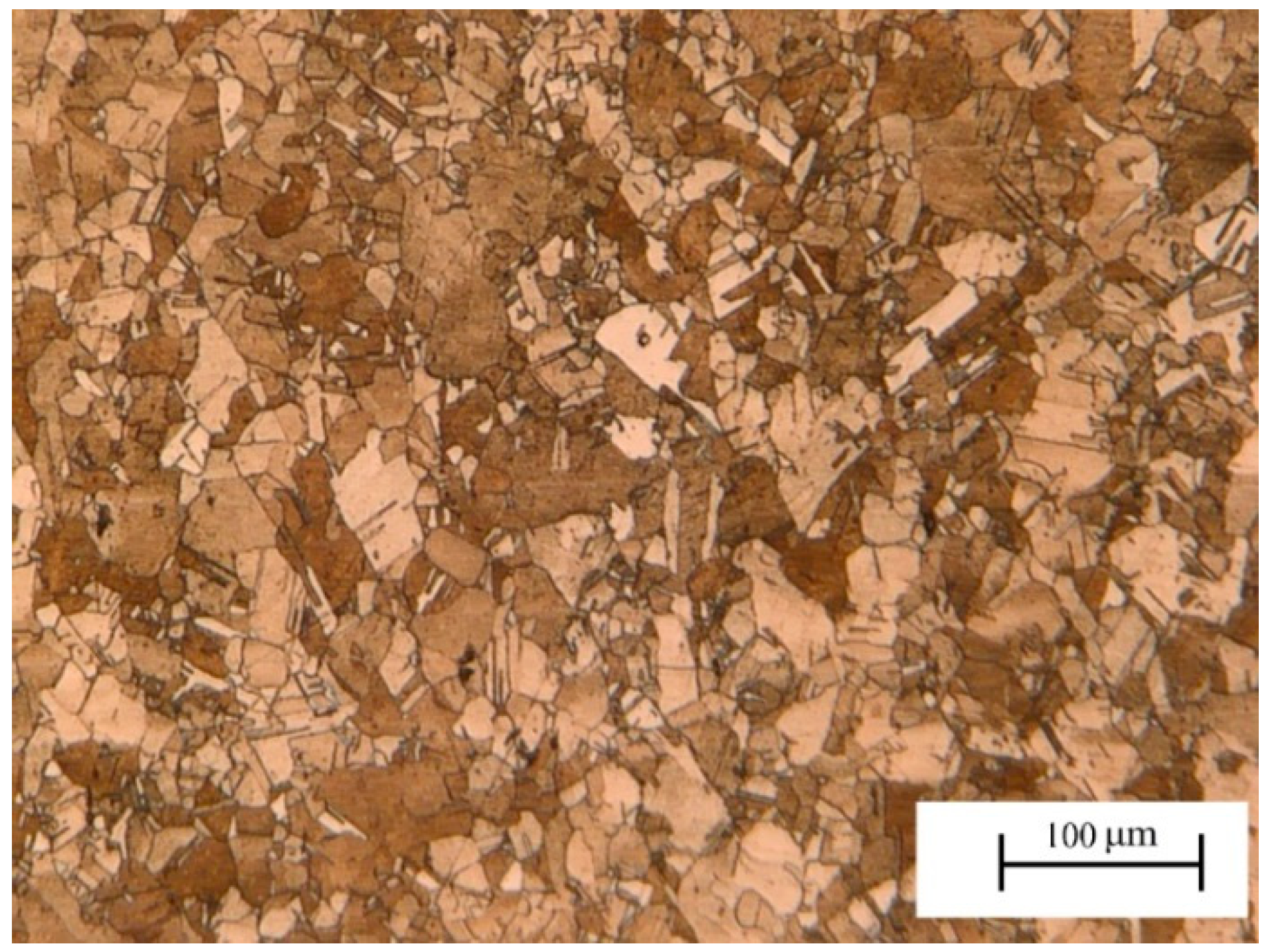
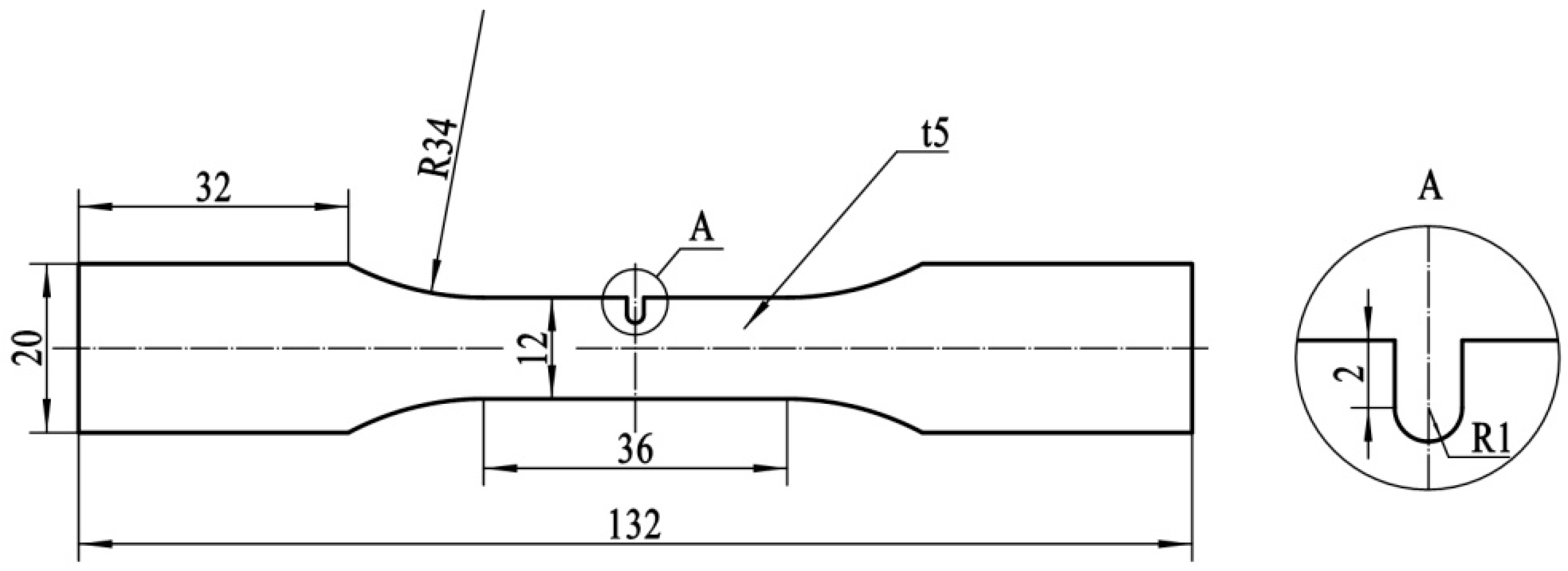
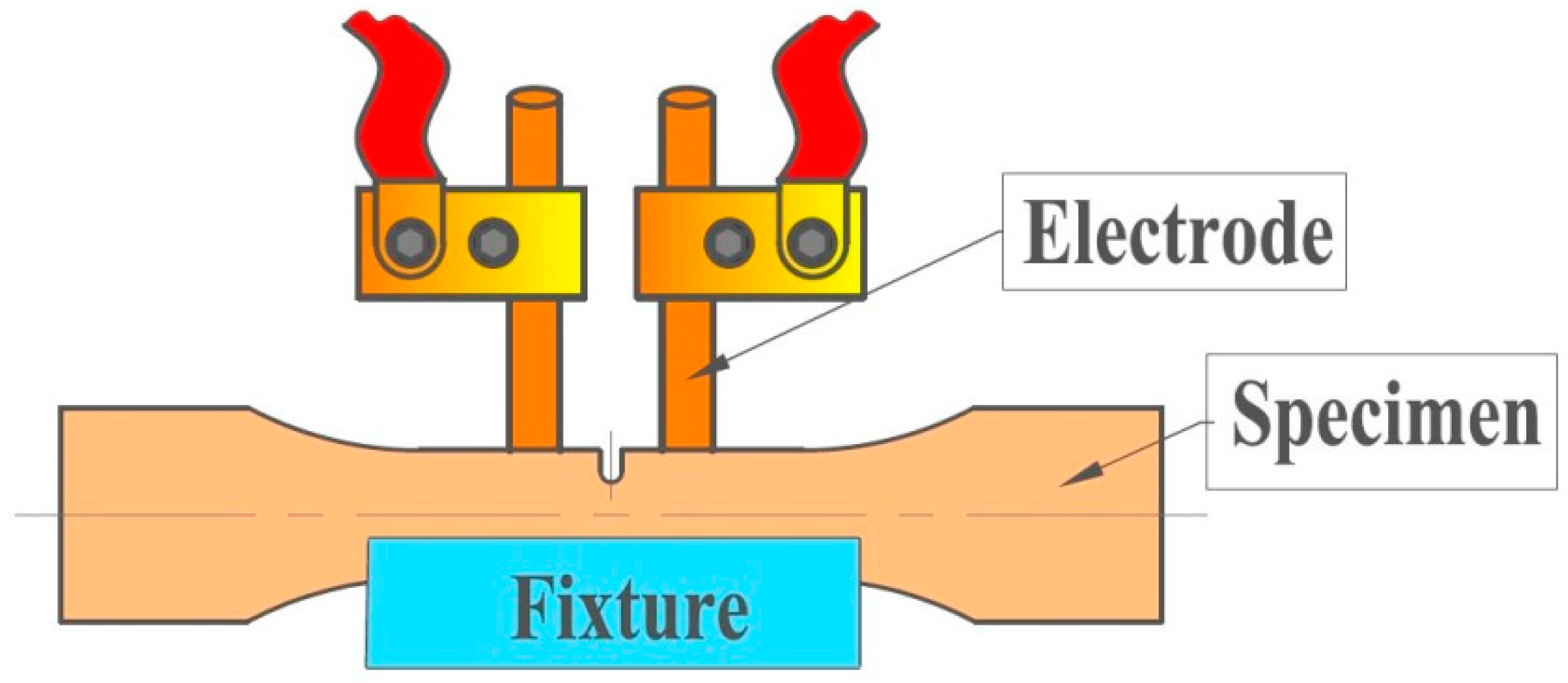
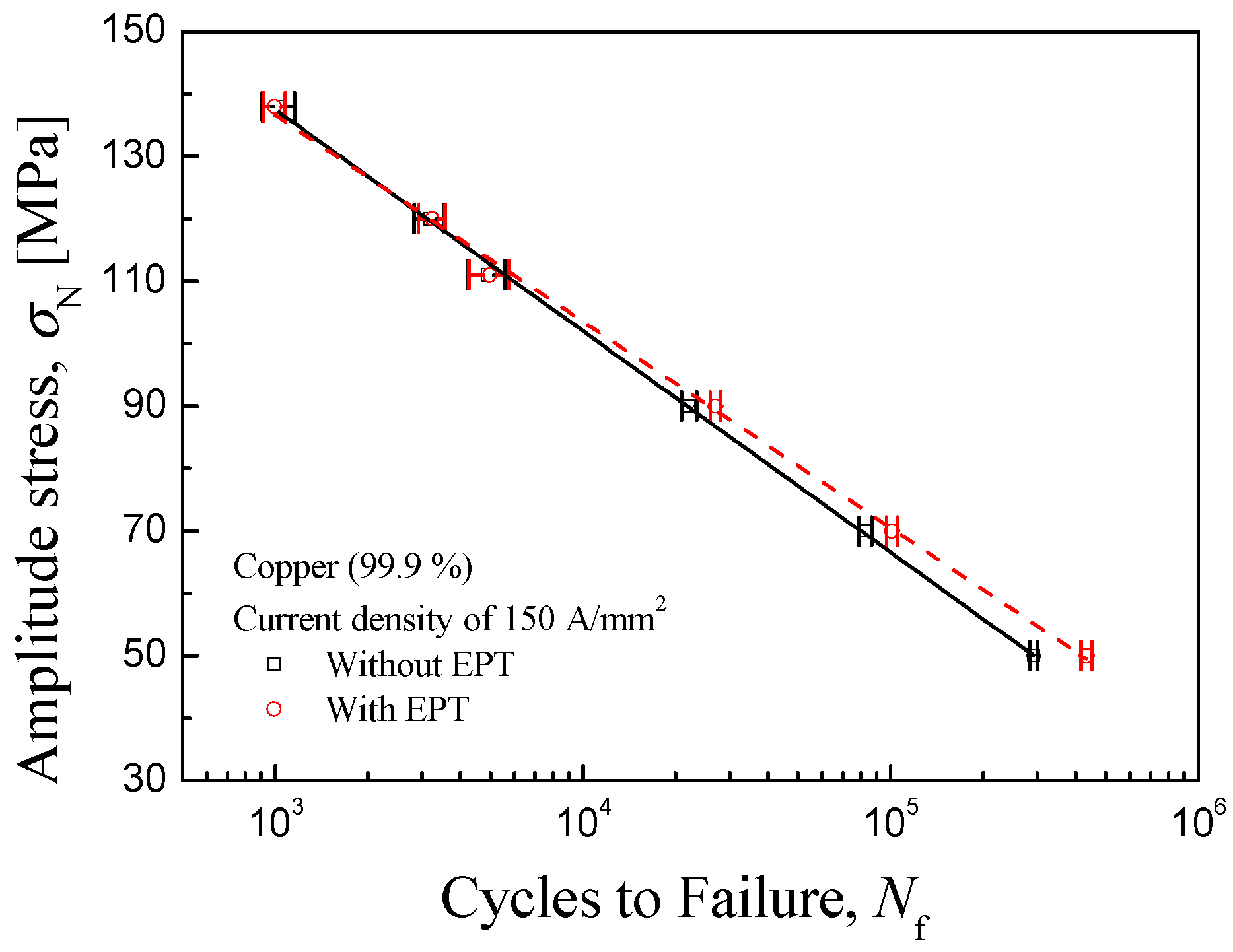
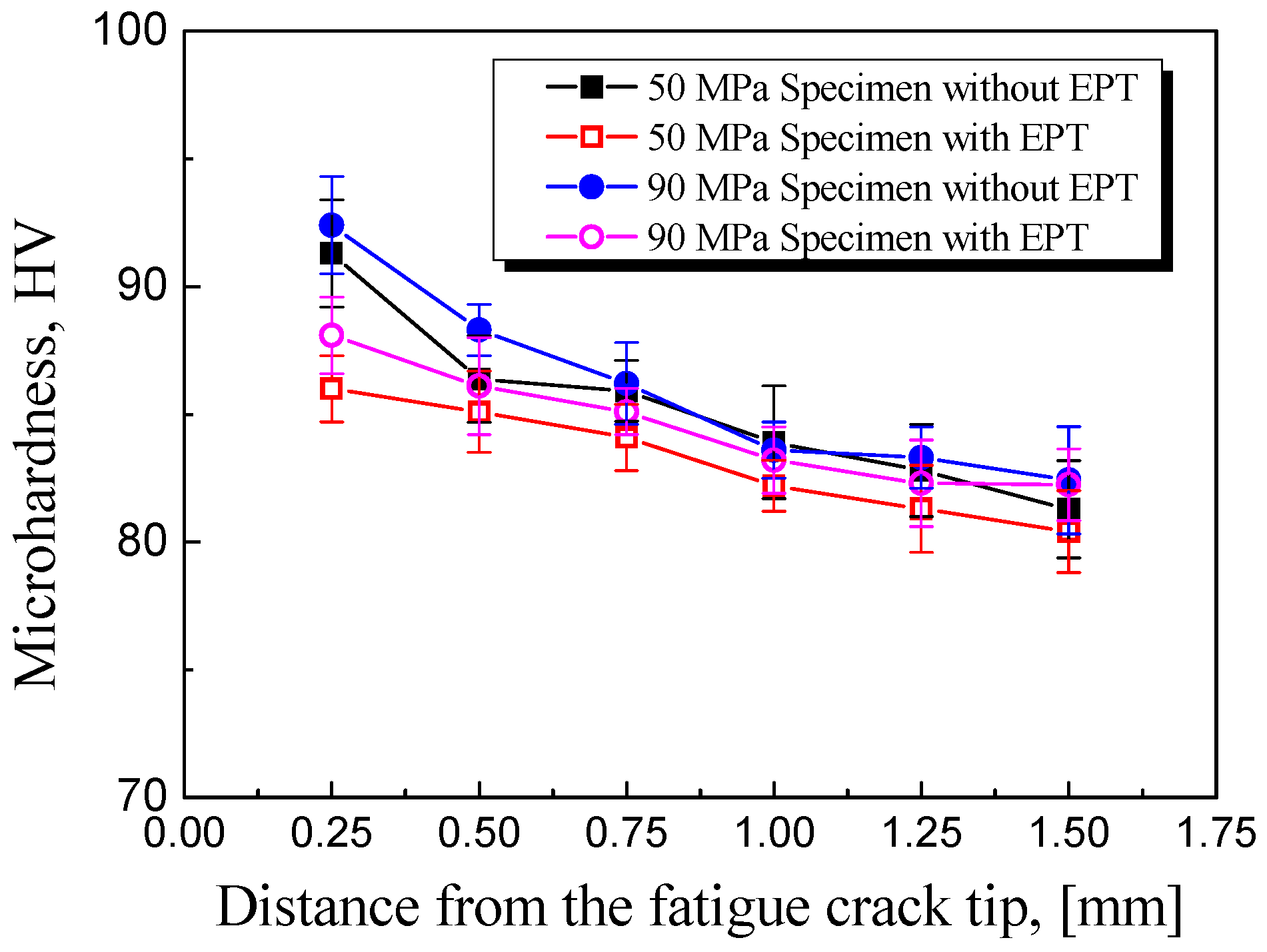


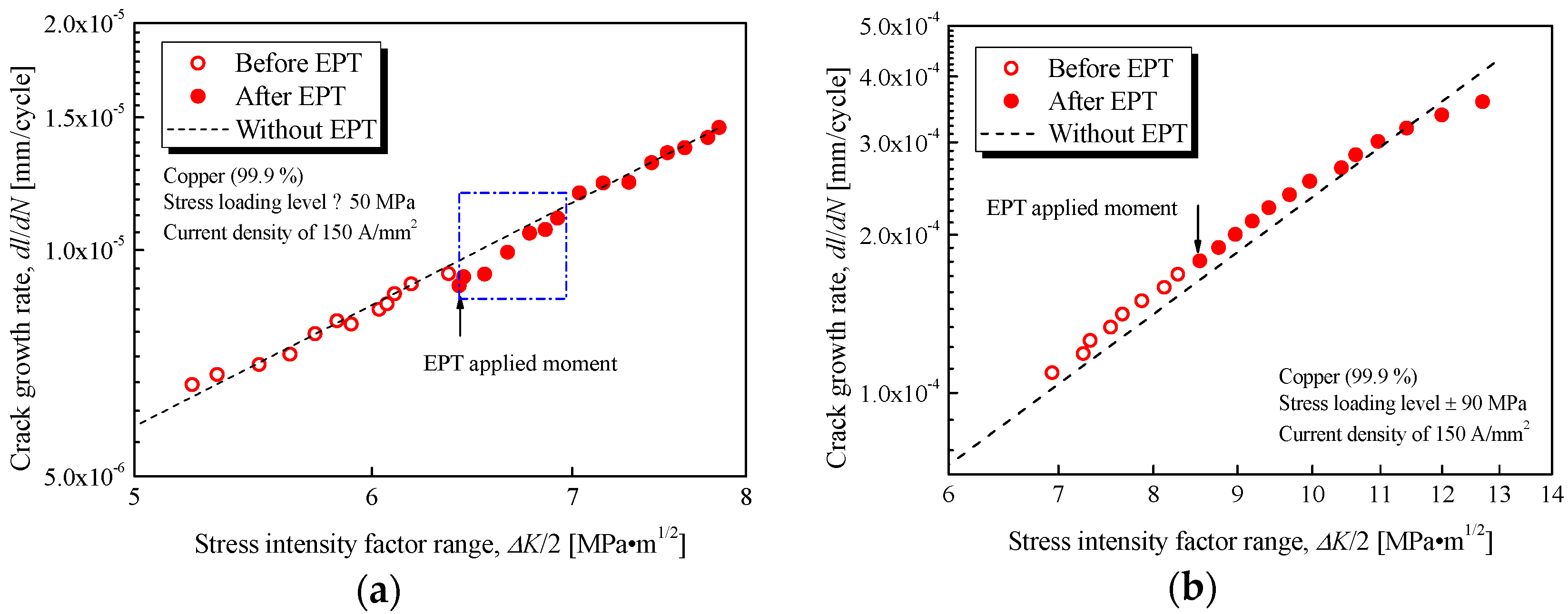
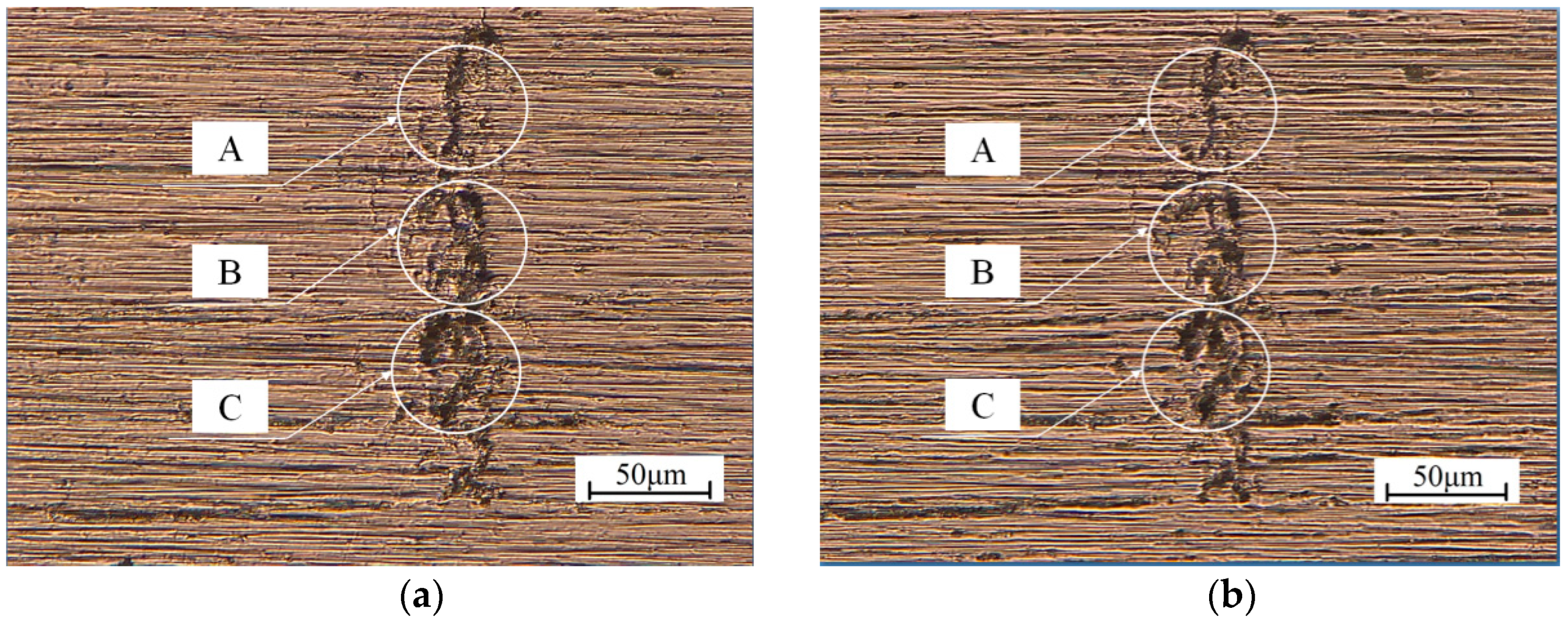
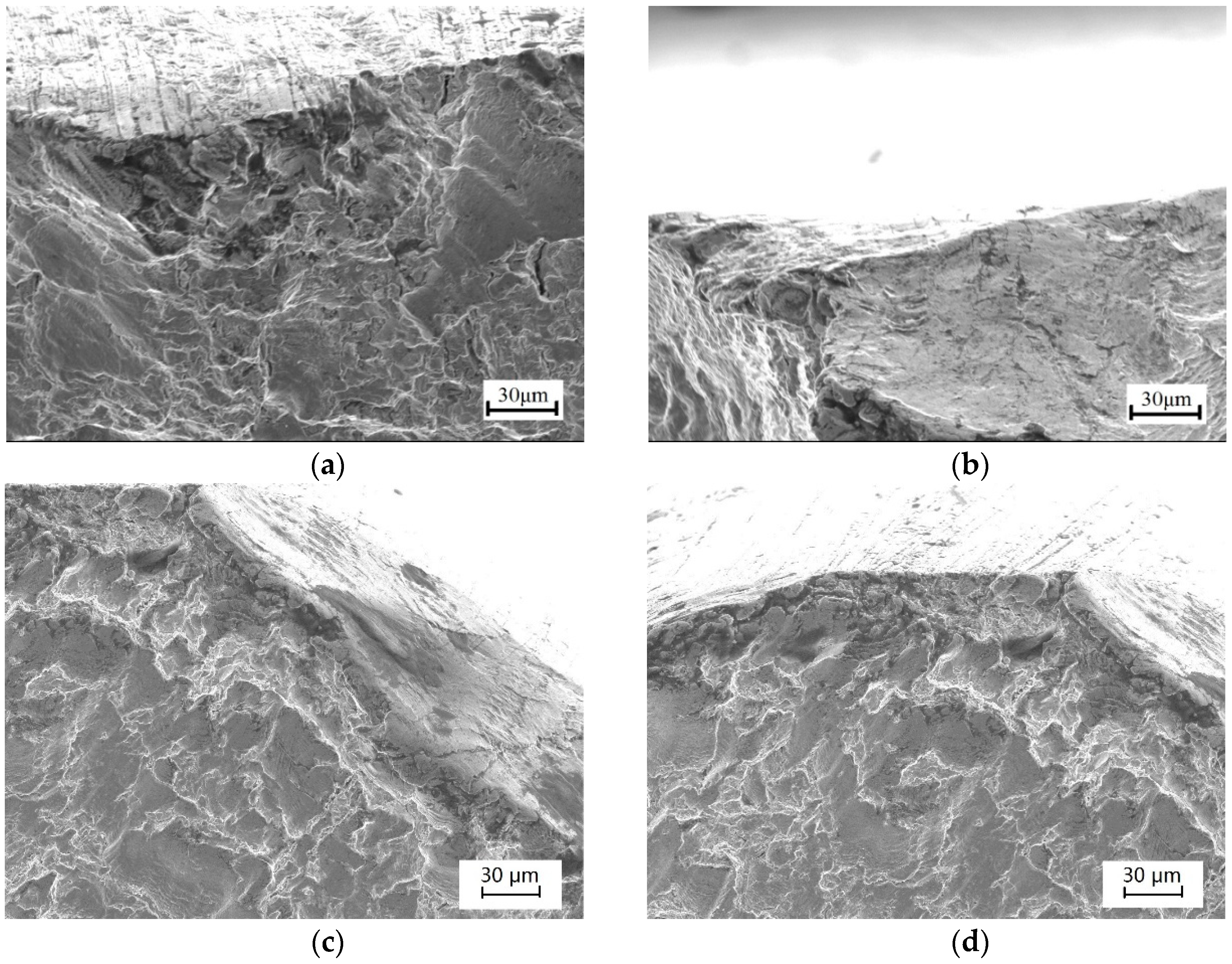
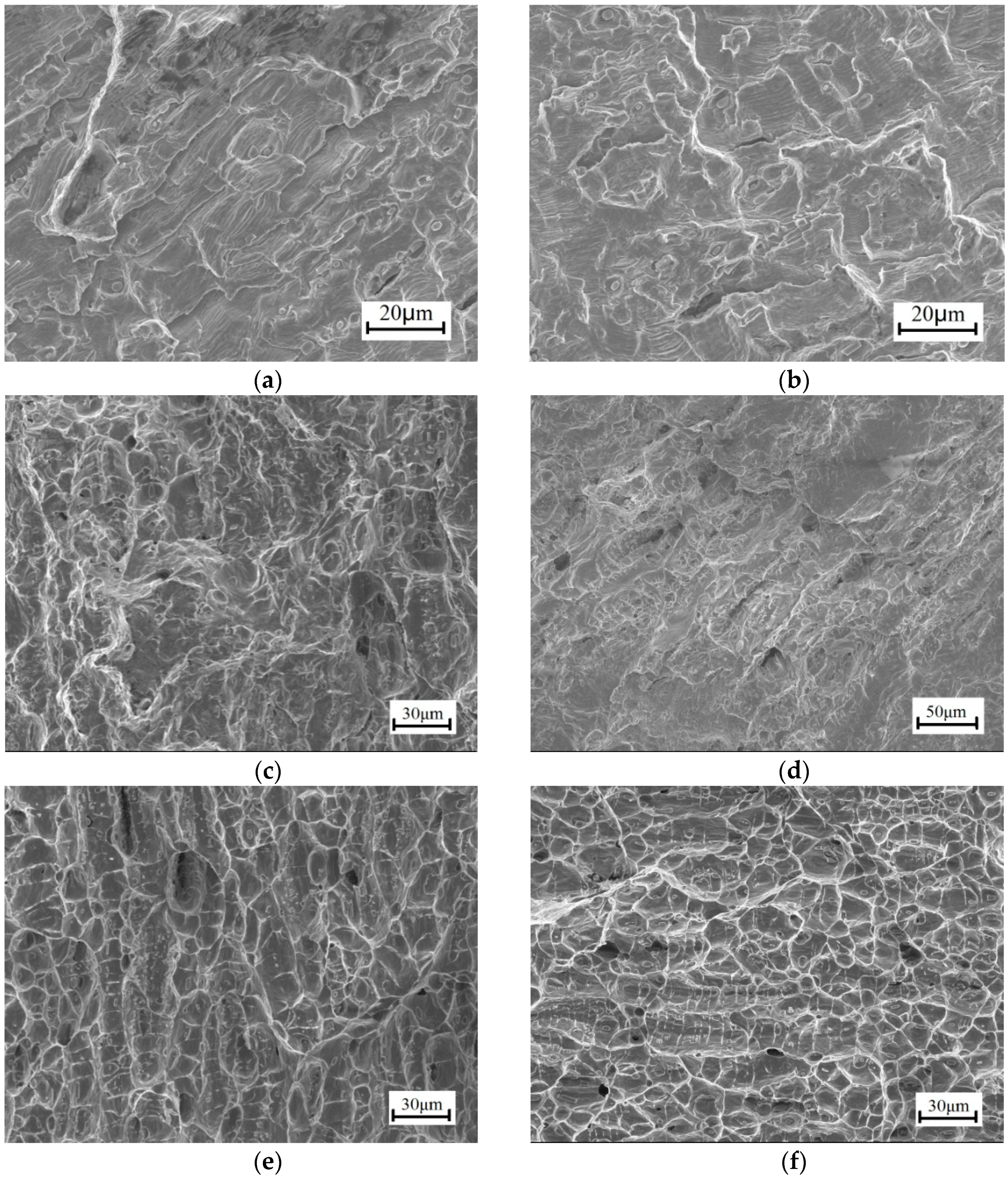
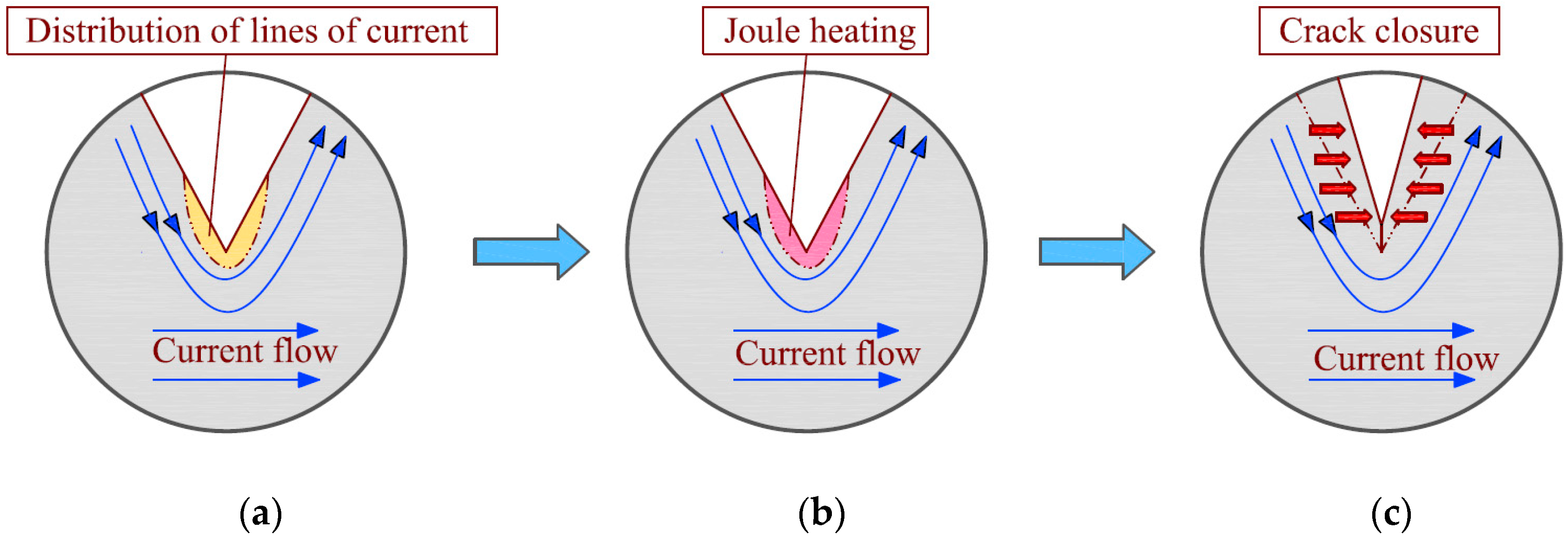
| Yield Strength at 0.2% Offset (MPa) | Tensile Strength (MPa) | Poisson’s Ratio | Young’s Modulus (GPa) | Elongation (%) | Hardness (HV) |
|---|---|---|---|---|---|
| 180 | 240 | 0.33 | 118 | 28 | 82.4 |
| Stress Level [MPa] | ±50 | ±90 |
|---|---|---|
| Current density [A/mm2] | 150 | 150 |
| Pulsed duration [ms] | 0.5 | 0.5 |
| Number of times of current pulse in 5 s | 4 | 4 |
© 2018 by the authors. Licensee MDPI, Basel, Switzerland. This article is an open access article distributed under the terms and conditions of the Creative Commons Attribution (CC BY) license (http://creativecommons.org/licenses/by/4.0/).
Share and Cite
Yin, Y.; Chen, H.; Morita, Y.; Toku, Y.; Ju, Y. Effect of Electropulsing Treatment on the Fatigue Crack Growth Behavior of Copper. Materials 2018, 11, 2168. https://doi.org/10.3390/ma11112168
Yin Y, Chen H, Morita Y, Toku Y, Ju Y. Effect of Electropulsing Treatment on the Fatigue Crack Growth Behavior of Copper. Materials. 2018; 11(11):2168. https://doi.org/10.3390/ma11112168
Chicago/Turabian StyleYin, Yan, Haibo Chen, Yasuyuki Morita, Yuhki Toku, and Yang Ju. 2018. "Effect of Electropulsing Treatment on the Fatigue Crack Growth Behavior of Copper" Materials 11, no. 11: 2168. https://doi.org/10.3390/ma11112168
APA StyleYin, Y., Chen, H., Morita, Y., Toku, Y., & Ju, Y. (2018). Effect of Electropulsing Treatment on the Fatigue Crack Growth Behavior of Copper. Materials, 11(11), 2168. https://doi.org/10.3390/ma11112168





